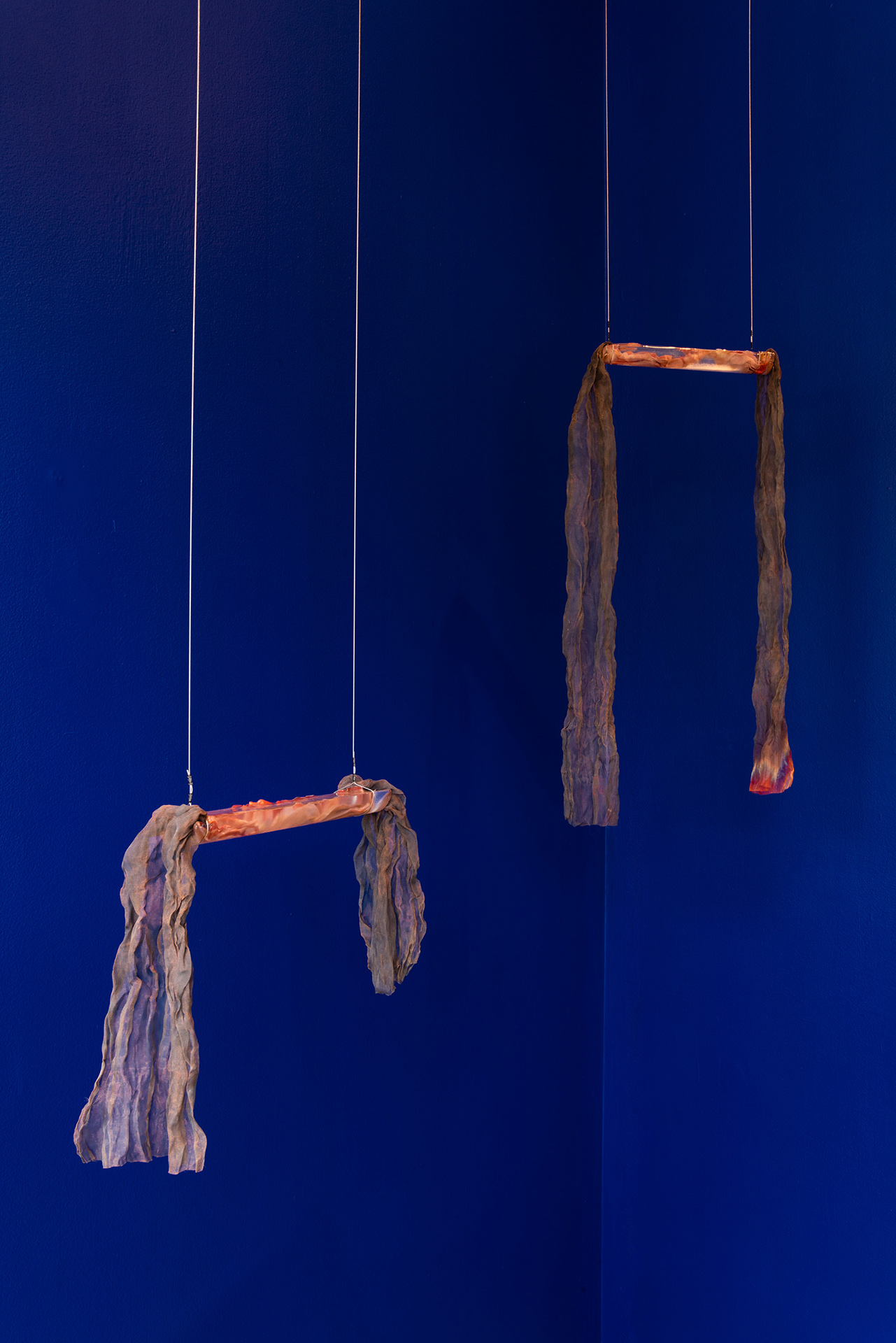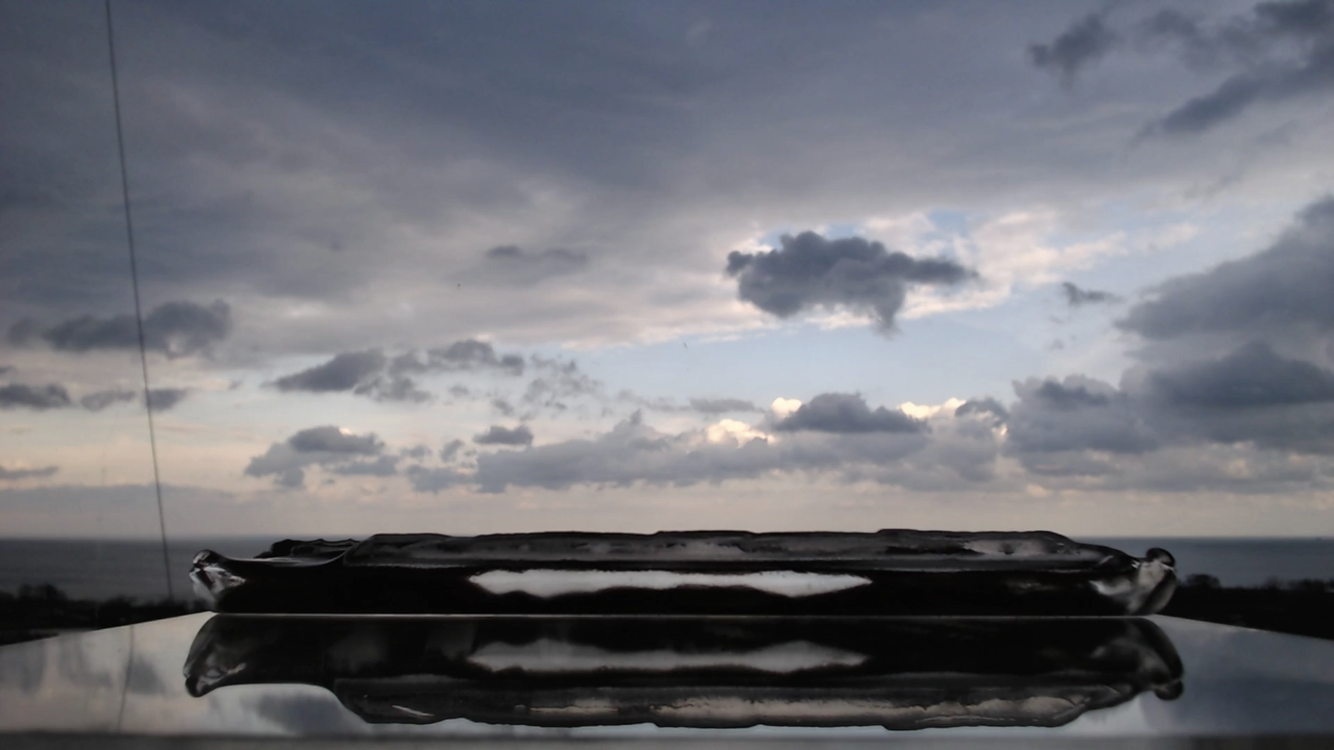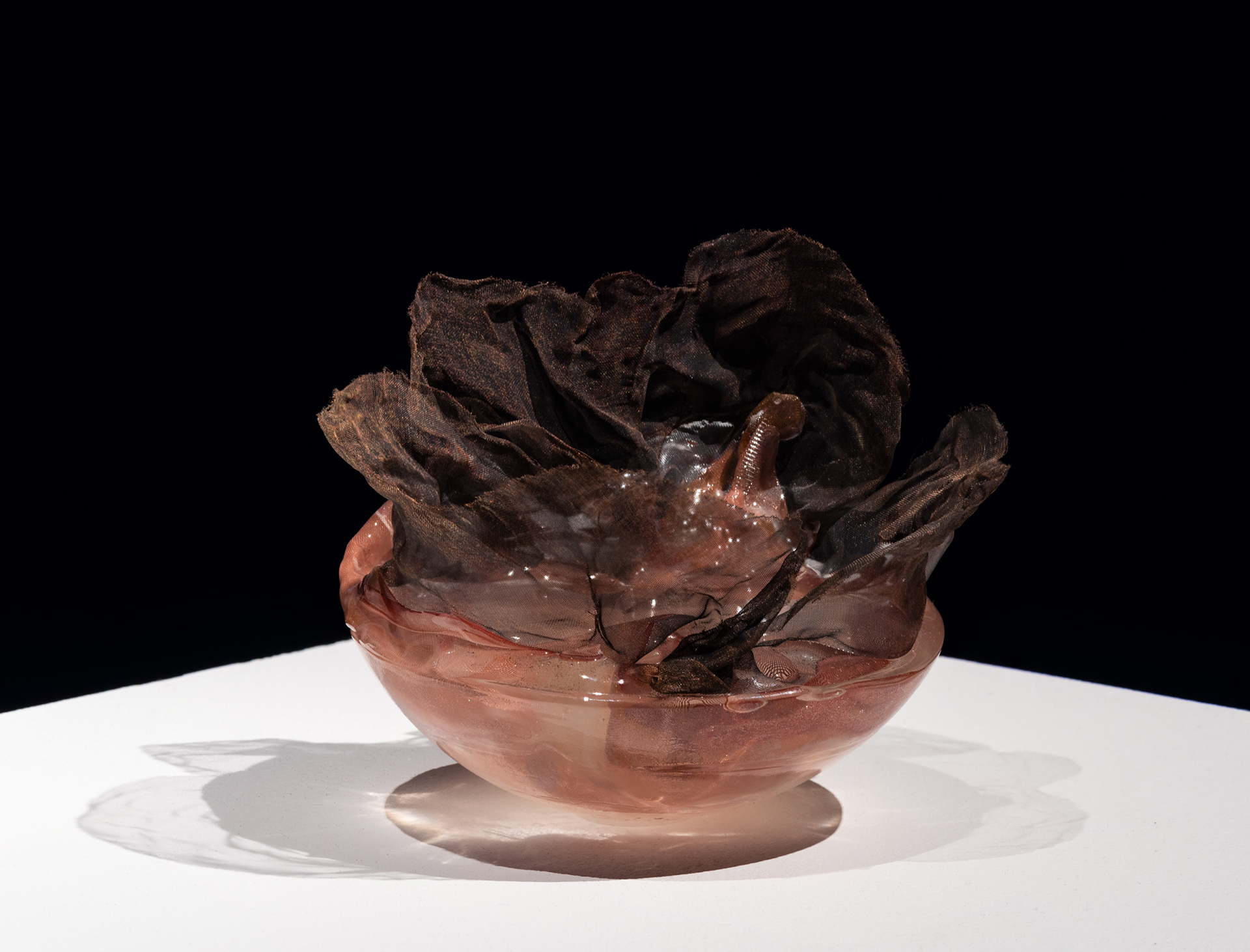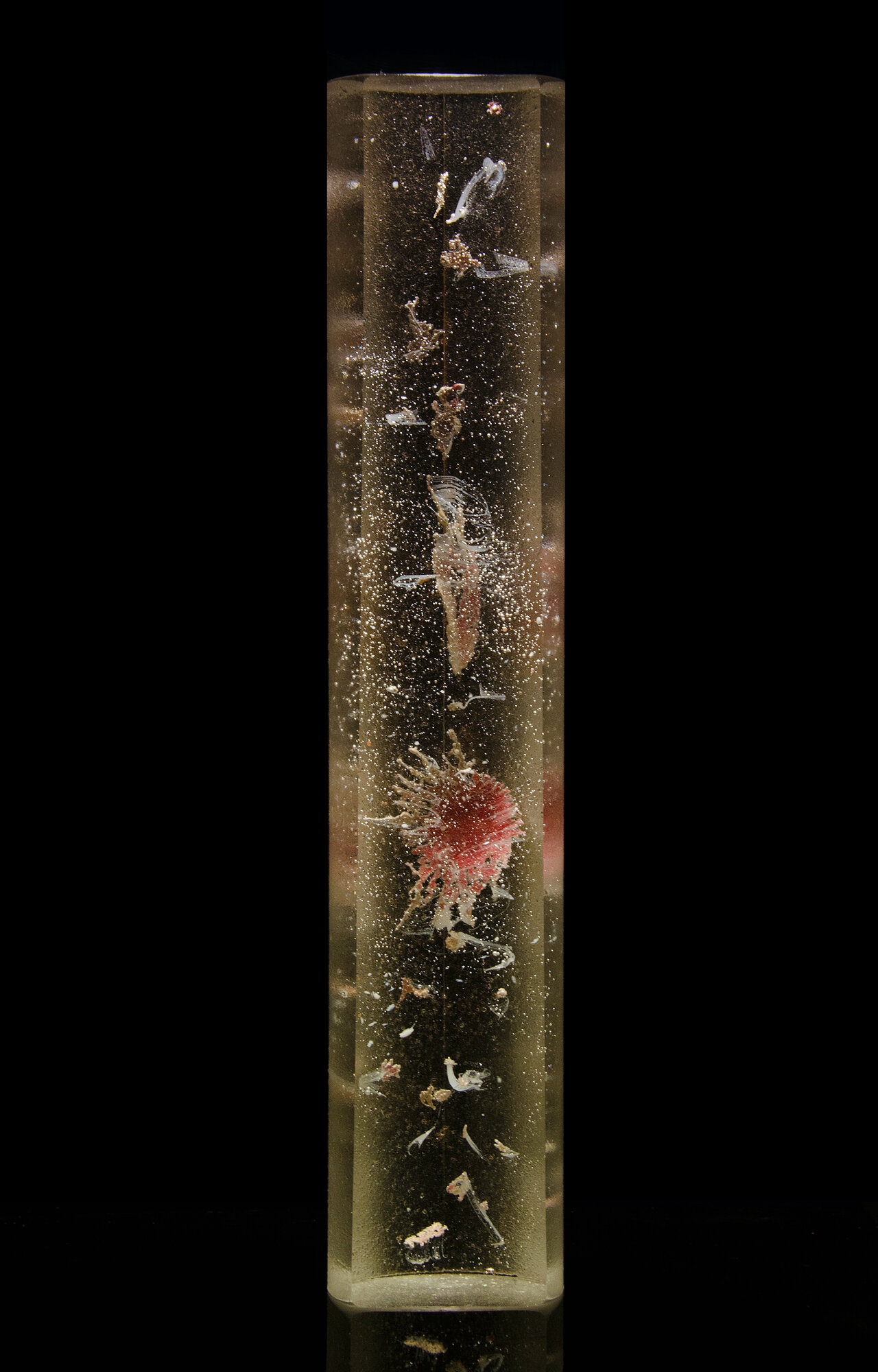Sand is a material of erosion, where time disperses granules into shape-shifting bodies of past and present imprints. These grains come from mountains, minerals, seashells, and plastic. They create deserts and beaches, while we use it to build roads and architecture. As sand’s form is shaped by surrounding wind, water, life, and debris, it is constantly moving and changing. Time is simultaneously being embedded and erased. Past histories coalesce.
Before sand, there are mountains, volcanoes, and molten lava; and before glass there is molten sand. Glass becomes a reconfiguration of a mountain, a landscape of glass, which we navigate through and around every day. Glass is a ubiquitous material that is both invisible and ever-present. Its form is infinitely recyclable and mutable; as vessels, mirrors, and interfaces between us and other places. It is in the center and periphery of our daily lives.
Originally inherited from the stars, copper is a conductor of electricity that runs throughout the architecture and devices we inhabit. It is also a vital mineral that aids in the production of red blood cells, keeping us alive. Copper is a material that is intrinsically tied to our survival and conveniences. As the structure of glass will hold for a million years without changing, copper forms an atmospheric finish to preserve itself, as a greenish blue patina.
Unearth brings together a new series of glass and copper sculptures that point towards the nature of immateriality through the mutability of form. These ancient materials build the digital interfaces and architectures we access everyday; framing our experiences. For many years, I have wanted to work with glass. I see it as an ideal medium relating to immateriality; glass particles/sand as digital dust/pixels, existing as an infinitely mutable form. When the opportunity to work with Upterior’s Waken Glass arose, I was excited by the potential of using copper in tandem with glass. They are the first studio to unite these materials together, into a new medium. I decided to create sculptures for birds, turning the gallery into an aviary where viewers become birders of imagined entities. I first designed Perches, sculptures alluding to the idea of being at a threshold. “To perch” means to sit on or be near the edge of something.
While working at the studio in Poland, other forms were experimented with in addition to the perches. In one week, 11 different sculptures were made; Perches, Nests, Core samples, Prisms, and Troughs. Each form was embraced for its imperfections. To embrace these characteristics is to point towards the contrast of working digitally, the strive for perfection, mimesis of reality, and the infinite reproductions that occur. Only a few surfaces were polished to reveal refractive qualities. The roughness and texture was fully embraced and left as is. Unexpected moments occurred in the sculptures as a result of being spontaneous and intuitive throughout the fabrication process. Risks were taken and if something was going to break, so be it. Perches were overstuffed with copper mesh, which resulted in blackened shadows. Molten copper was thrown against surfaces to create exploding lifeforms for Core samples; some of which are similar to those that show up in my Clouds series.
Throughout the conception of Unearth, many nature oriented activities were in my everyday that inspired the show; birding, going to the lake, watching wildlife cams like “Pete’s Pond”, and spending time in deserts. Oil painting as well. As painting was my first love, I have come back to it after many years. The surface and depth relationships I create on screen are naturally occurring on canvas; inviting an examination of how my vision has been influenced by computer collaboration. One aspect of producing digital work is that the intentions of the artist can be ambiguous, where it is difficult to determine what the artist created and what the software created. The nuanced process of oil painting has made me reflect on my digital gestures and how to dissolve that ambiguity. This is present in Refract, through the intentional pushing and pulling of color and light to create an illusion of surface and depth; approaching immateriality as if it’s viscous without the expected markings of a digital brush.
Refract is a digital painting that was created over a 6 month time period, embedded with my daily activities while moving through various programs. In addition to Refract being informed by my painting practice, it is also informed by the prismatic qualities of glass, refracting segments of my everyday back to the surface. While Refract is meant to be experienced by the whole body at 6’ x 6’, its details elicit an intimate exploration just as the sculptures invite you to see worlds of light.
Alongside the sculptures and Refract is a nature cam. The nature cam transmits a sculpture through space and time, allowing it to be viewed across the world from a Chicago high rise. It is situated facing directly east, capturing the sun and moonrise over Lake Michigan while a nearby bird sanctuary fills the sky. The live feed can be seen as a projection in the gallery and at birdsmadeearth.com. After the exhibition, archived footage will be present on the website.
Lastly, is the photograph of the constellation Cygnus I captured in the Sahara. It was an unplanned, spontaneous encounter with the constellation. A celestial bird sighting. Cygnus and the webcam creates an awareness of expansive space, extending the works from the gallery to the cosmos. It is with the idea of expansive space I wish the viewer to occupy while experiencing the exhibition.
Birding has been the biggest inspiration in the creation of Unearth. It has been a transformative practice, bringing a renewed awareness to the everyday and great appreciation for all that exists outside of the screen. It has also made me reconsider and question my role as an artist today. As we’re entering a dire time, where extinction, social collapse and displacement is happening, how are we to spend our time? As humans, as artists, what are we to do? I don’t have answers to these questions. These works in some way are helping me sort out what I wish to spend my time doing. Birding and observing nature certainly begs the question of how to preserve and protect it.
While working on this exhibition I couldn’t help but think how the landscape of glass and copper we navigate through and around every day is responsible for billions of bird deaths. Nearly 1 billion birds die a year crashing into windows, and another billion birds die crashing into power lines. These threats are as looming to their extinction as climate change is. If bird populations decline, everything will follow. Their important role in balancing insect populations, dispersing seeds, and creating habitable ecosystems will vanish. When Mao Zedong created the Great Sparrow Campaign in 1958 in China, he asked the population to bang pots and pans to tire and kill flying sparrows. Hundreds of millions of sparrows died, creating a drastically unstable ecosystem that resulted in 30 million people starving due to a famine, just a few years later.
Although this show is not centered around anthropocentric urgencies, I wish for viewers to question their own desires, be aware of the turning inside and around them. More importantly, I wish for viewers to be reminded of how magical Earth is through its ancient forms and skies, and why it’s essential to preserve and protect it for future generations. The nature of Waken Glass is a reminder to strive for a harmonious balance between what we create for conveniences and what we create to survive, through the union of glass, copper and the natural processes it endures.
S . L .









